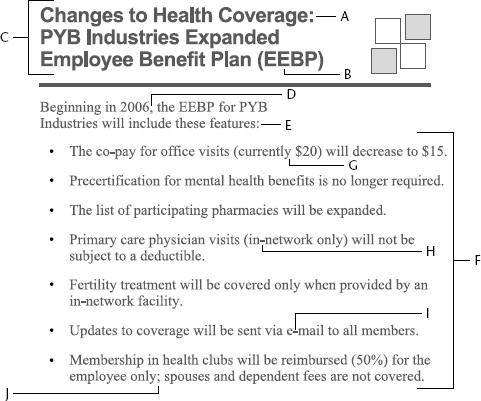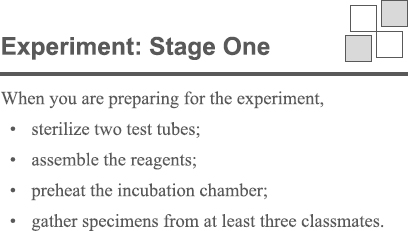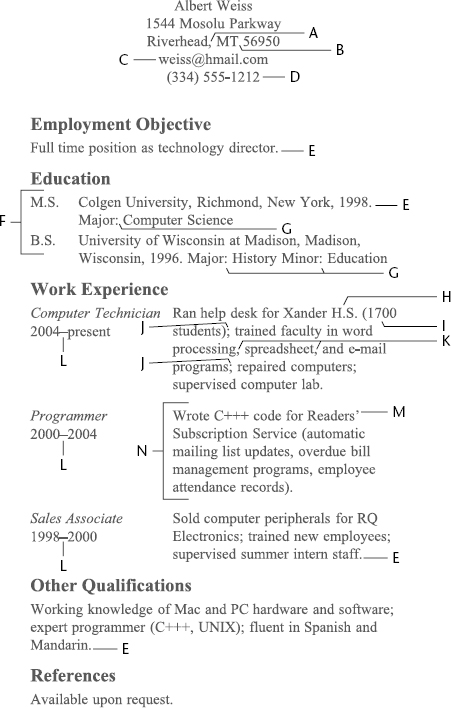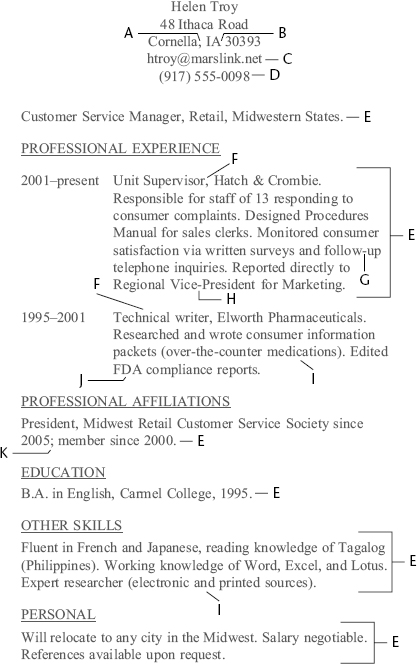Chapter 17
Presentations and Resumes
In the “good old days” when a business executive or a professor wanted to present information, a chalkboard or a sheet of paper was the only option. Because of advances in computer technology, little effort is now required to display all sorts of charts, graphs, illustrations, and text. As visual literacy has increased, however, so has time pressure. Readers or audiences want information quickly and coherently. Thus it is not surprising that the standard paragraph form, still a workhorse for report writers, is frequently accompanied by bulleted lists. Bulleted lists are also key in resume writing.
PowerPoint, Word, and similar programs make the writer’s task easy by supplying templates for titles, introductory phrases, and bullet points. Unfortunately, computer programs don’t insert proper punctuation automatically. Fortunately, today’s writers have a great deal of leeway in punctuating bulleted lists. Some of the stricter rules—that all but the last bullet point in certain types of lists must end with a semicolon, for example—may seem stodgy and outdated to some readers, though such punctuation is correct.
This chapter contains several examples of presentation slides and resumes. The first two “slides” are punctuated in the traditional way. The next shows acceptable variations. Keep these general points in mind when creating presentations or writing a resume:
- Centered titles are not placed in quotation marks and do not contain periods, except as needed for abbreviations. If the title is an exclamation or a question, the title may end with an exclamation point or a question mark. If the title is followed by a subtitle, a colon separates the two.
- Bullet points that are complete sentences generally begin with a capital letter and end with a period or other endmark.
- Bullet points that are not complete sentences normally begin with a lowercase letter and don’t take endmarks. This sort of bullet point may end with a semicolon. As mentioned earlier, the semicolon is often omitted these days.
- If the introduction to a bulleted list is a complete sentence, it is usually followed by a colon. Many contemporary writers place a colon after an introduction that is not a complete sentence, though this practice is technically incorrect.
- An introduction that is not a complete sentence may be followed by a dash, a comma, or by no punctuation at all.
- A colon should not follow an introduction that ends with a form of the verb to be (is, are, was, will be, have been, etc.). Normally, no punctuation follows introductions ending with a form of the verb to be.
- A colon should not follow an introduction that ends with a preposition (of, for, by, in, after, from, and so forth). Again, no punctuation is placed after an introduction ending with a preposition.
Be Consistent
Bullet points should resemble each other. If the first bullet point is a complete sentence, all the bullet points should be complete sentences. If the first is a command, the rest of the bullets should also follow that pattern.
Wrong:
- sell raffle tickets
- silent auction
Right:
- raffle
- silent auction
Also Right:
- sell raffle tickets
- conduct silent auction
TRADITIONAL BULLETED LIST: COMPLETE SENTENCES

Punctuation in a Traditional Bulleted List
A traditional bulleted list may be introduced, as the example illustrates, by a complete sentence. The bullet points are all complete sentences.
A. A colon separates a title (Changes to Health Care Coverage) from a subtitle (PYB Industries Expanded . . . Plan).
B. An acronym—an abbreviation formed from the first letter of each of several words—does not include periods.
C. The left-aligned title is not placed in quotation marks.
D. Introductory expressions of time, especially when they contain a verb form (Beginning), are set off from the main part of the sentence by a comma.
E. A complete-sentence introduction to a bulleted list is usually followed by a colon, though a period is also acceptable.
F. As these bullet points are all complete sentences, each should be followed by a period.
G. Extra information is inserted into a sentence with parentheses.
H. A hyphen makes the meaning of in-network easier to grasp. Without a hyphen, the reader may perceive inn as the first syllable, as that combination of letters is popular in English words.
I. A hyphen is generally inserted in e-mail, though the word is sometimes written without one.
J. A semicolon links two complete sentences without a joining word such as and, but, nor, or yet.
TRADITIONAL BULLETED LIST: INCOMPLETE SENTENCES

Punctuation in a Traditional Bulleted List: Incomplete Sentences
In this presentation slide, neither the introductory expression nor the bullet points constitute a complete sentence. However, a complete sentence results when each of the bullet points is attached to the introductory expression:
When you are preparing for the experiment, sterilize two test tubes. (complete sentence)
When you are preparing for the experiment, assemble the reagents. (complete sentence)
When you are preparing for the experiment, preheat the incubation chamber. (complete sentence)
When you are preparing for the experiment, gather specimens from at least three classmates. (complete sentence)
The punctuation reflects the fact that the entire bulleted list is a series of complete sentences created by attaching the bullet point to the introduction. In proper English usage, the introductory expression is followed by a comma, as it would be as part of the sentence completed by the bullet point. Each bullet point, excluding the last, ends with a semicolon because the entire list is linked. A semicolon links complete sentences. The last bullet point ends with a period.
This bulleted list follows the traditional rules very strictly. If you use this sort of punctuation, be aware that some readers may find the semicolons fussy and overly precise. Modern usage gives you a few additional options. You may place no punctuation at the end of the introductory expression or at the end of the bullet points. You may insert a colon at the end of the introductory expression, and you may insert a period at the end of the last bullet point but no punctuation after the other bullet points.
Keep in mind that altering the traditional punctuation leaves you open to criticism from those who value correct usage above all else.

Punctuation in a Nontraditional Bulleted List
The presentation slide on the facing page varies from traditional punctuation rules but is still acceptable in formal English. The slide has a title (Films of Pedro Almodovar) with no separate introductory phrase or sentence. The bullet points are numbered, and the subtopic bullet points are preceded by dashes. A few details:
A. The numbers in a free-standing list are followed by periods. If the numbers were placed in parentheses, no periods would be inserted.
B. Titles of full-length works are not placed in quotation marks. Use italics, bold type, or underlining instead.
C. Extra information is inserted in parentheses.
D. Em (full-size) dashes set off each subtopic. No space separates the end of the em dash from the first word in the subtopic.
E. Within the bullet points, normal punctuation rules apply. Director’s is possessive, as the apostrophe indicates.
F. The bullet points are not followed by endmarks (period, question mark, exclamation point).

Punctuation in a Resume
A. A comma separates the city from the state abbreviations. Two-letter state abbreviations are capitalized and written without periods.
B. No comma separates the state from the zip code.
C. An e-mail address may be underlined if it is an active link that the reader may click on. If you are submitting a resume on paper, not via e-mail, omit the underlining.
D. The area code is often placed in parentheses. Hyphens separate parts of the phone number.
E. The period here is optional, as this is not a complete sentence.
F. Traditionally, the abbreviations for university degrees (M.S. and B.S.) are capitalized and include periods. The more modern style omits periods.
G. The colon separates the general term (major, minor) from the specific (computer science, for example).
H. The abbreviation for high school (H.S.) includes periods.
I. Parentheses insert extra information into a sentence.
J. Semicolons separate items in a series when at least one item contains a comma.
K. Commas separate parts of one item in a series.
L. An en dash (longer than a hyphen but shorter than most dashes) shows a date range. A hyphen may be substituted if you wish.
M. An apostrophe indicates a plural possessive.
N. No item in this series contains commas, so the items may be separated from each other by commas.

Punctuation in a Resume
The punctuation and style of this resume differs from those used in the previous resume (see this section). In a resume, several styles of punctuation are considered proper, so long as you are consistent throughout. The rationale for the punctuation in this resume is as follows:
A. A comma separates the city from the state abbreviations. Two-letter state abbreviations are capitalized and written without periods.
B. No comma separates the state from the zip code.
C. An e-mail address may be underlined if it is an active link that the reader may click on. If you are submitting a resume on paper, not via e-mail, omit the underlining.
D. The area code is often placed in parentheses. Hyphens separate parts of the phone number.
E. In this resume, each statement—of employment goal, professional experience, education, and so on—is followed by a period. The style is consistent in every part of the resume.
F. The job title is separated from the name of the company by a comma.
G. Two words joined together to make one description (follow-up) are generally linked with a hyphen if the description precedes the word being described.
H. A hyphen separates two parts of a compound word (Vice-President).
I. Extra information is inserted into a statement with parentheses.
J. Acronyms (expressions created with the first letter of each of several words, in this case, FDA for Food and Drug Administration) do not take periods.
K. This statement contains two elements (President, Midwest Retail Customer Service Society since 2005 and member since 2000). Because one of those elements contains a comma, a semicolon is needed to differentiate one element from the other.